Revolutionizing Energy: Scientists Harness Sunlight to Convert CO2 and Plastic into Clean Fuel
CAMBRIDGE, ENGLAND — In a groundbreaking revelation that promises to redefine our energy landscape, scientists from the University of Cambridge have unveiled a method to produce clean and sustainable fuels by merely using sunlight and carbon dioxide captured from the air.
Solar-Powered Alchemy
Harnessing the power of the Sun has always been at the forefront of sustainable energy discussions. However, the recent research led by a Cambridge team presents a revolutionary perspective. Their innovative solar-powered reactor effectively transforms CO2 from ambient sources into a potentially limitless energy supply, a solution that can be amplified for industrial applications.
This pioneering approach draws inspiration from Carbon Capture and Storage (CCS) systems. Historically, these systems have focused on capturing CO2 to sequester it in underground storage facilities. Dr. Motiar Rahaman, a lead researcher from the university’s Department of Chemistry, envisions a different purpose for captured carbon. He explains, “Instead of relegating CO2 to underground storage, we have the technology to extract it from the air and transmute it into clean fuel.”
In essence, this could signify a significant departure from traditional fuel production methods, effectively sidelining the fossil fuel industry, which is largely blamed for exacerbating climate change.

A revolutionary discovery could change all the energy used by humanity
From Emissions to Energy
The ingenuity of the technology lies in its ability to actively sequester CO2, be it from industrial byproducts like flue gas or directly from the atmosphere. This captured gas undergoes a process wherein it’s passed through an alkaline solution, concentrating the CO2. This concentration makes it more amenable to be converted into syngas fuel, all under the benevolent energy of the Sun.
But the innovation doesn’t stop there. The team, in a bid to address the mounting problem of plastic waste, integrated it into the system. This addition not only aids in the production of syngas but also results in the creation of essential chemicals. One such byproduct is glycolic acid, a crucial component in the cosmetics industry.
Dr. Sayan Kar, a co-first author of the study, highlights the dual waste-management capability of this system. He remarks, “This solar-driven mechanism takes two detrimental waste products – carbon emissions and plastic – and metamorphoses them into something of value.”
A Glimpse into a Sustainable Future
The implications of this research are profound. At its core, it represents a paradigm shift in how we perceive waste and renewable energy. The prospect of converting abundant CO2 and plastic waste into clean fuel and useful chemicals using only sunlight seems like a leap into science fiction. Yet, as Dr. Kar emphasizes, “The fact that we can pluck CO2 from the very air we breathe and derive utility from it using just sunlight is not just special—it’s transformative.”
As the world grapples with the dual challenges of climate change and waste management, solutions like these offer a beacon of hope. The journey from laboratory to large-scale industrial application is bound to be filled with challenges. Yet, the promise held by this technology—a world where waste becomes a resource, and the Sun, our chief energy benefactor—ushers in a new era of sustainable living and energy production.
©globalgreenhouse.eu




